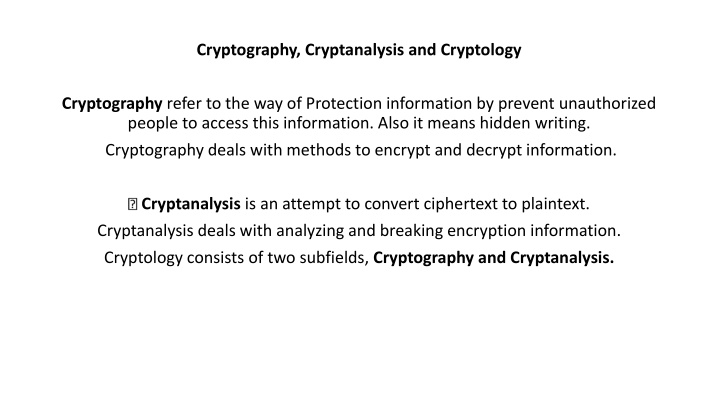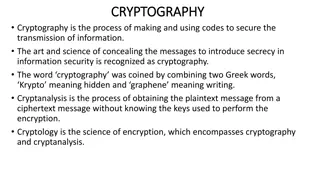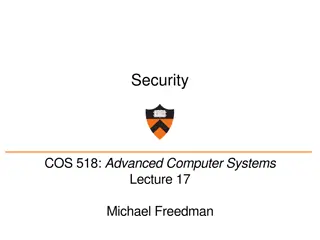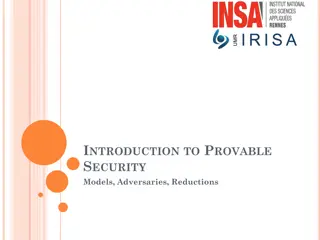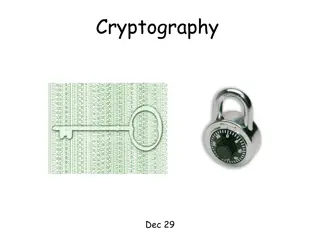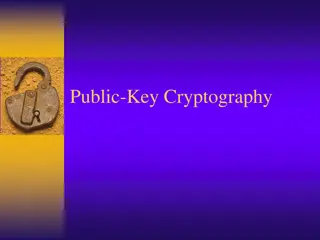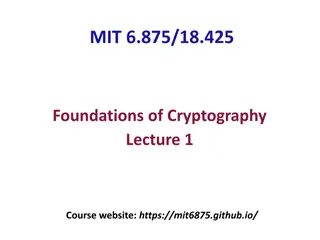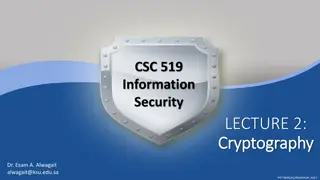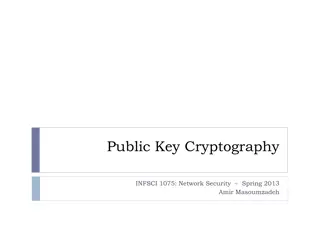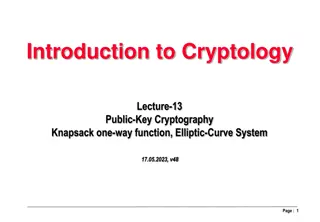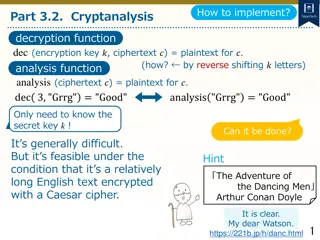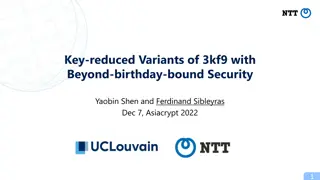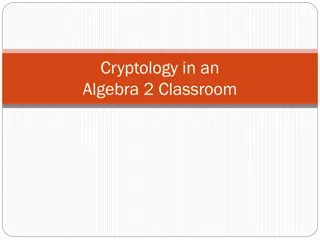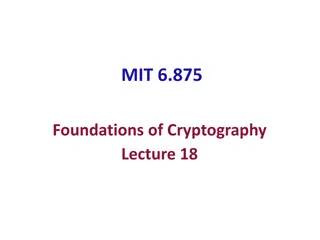Introduction to Cryptography, Cryptanalysis, and Cryptology
Cryptography involves protecting information by encrypting and decrypting data, while cryptanalysis focuses on breaking encryption methods to access hidden messages. Cryptology encompasses both cryptography and cryptanalysis. Encryption encodes messages to prevent unauthorized access, while decryption decodes encrypted messages back to their original form. A cryptosystem defines rules for encryption and decryption algorithms. Understanding the terminology and key concepts in this field is crucial for secure communication.
Download Presentation

Please find below an Image/Link to download the presentation.
The content on the website is provided AS IS for your information and personal use only. It may not be sold, licensed, or shared on other websites without obtaining consent from the author.If you encounter any issues during the download, it is possible that the publisher has removed the file from their server.
You are allowed to download the files provided on this website for personal or commercial use, subject to the condition that they are used lawfully. All files are the property of their respective owners.
The content on the website is provided AS IS for your information and personal use only. It may not be sold, licensed, or shared on other websites without obtaining consent from the author.
E N D
Presentation Transcript
Cryptography, Cryptanalysis and Cryptology Cryptography refer to the way of Protection information by prevent unauthorized people to access this information. Also it means hidden writing. Cryptography deals with methods to encrypt and decrypt information. Cryptanalysis is an attempt to convert ciphertext to plaintext. Cryptanalysis deals with analyzing and breaking encryption information. Cryptology consists of two subfields, Cryptography and Cryptanalysis.
Terminology Encryption is the process of encoding a message so that its meaning is not obvious. Other name for Encryption are (encoding, encipher). Decryption is transforming an encrypted message back into its normal. .(other name for Decryption are (decoding, decipher). System for encryption and decryption is called a cryptosystem. The cryptosystem involves a set of rules for how to encrypt the plaintext and how to decrypt the ciphertext. The encryption and decryption rules, called algorithms. Plaintext: original form of a message. Plaintext is the message to be transmitted or stored. Ciphertext: the encrypted form.
Encode is the process of convert the message into a representation in a standard alphabet. Decode is the process of convert the encoded message back to its original alphabet and original form.
P or M: plaintext message -----------------C: ciphertext --message E :Encryption -----------------D: Decryption C = E(P) and P = D(C) P= D(E(P))(without key) C = E(K,P) and P = D(K,E(K,P)) (with same key) (symmetric) C = E(KE,P) and P = D(KD, E(KE,P)). (with different key) (Asymmetric).
Breakable Encryption An encryption algorithm is called breakable when, given enough time and data, an analyst can determine the algorithm. Cryptanalysis Cryptanalysis refers to the study of ciphertext , or cryptosystems with a view to finding weaknesses in them that will allow retrieval of the plaintext from the ciphertext , without necessarily knowing the key or the algorithm.
Cryptanalyst can attempt to do any or all of six different things: 1) Break a single message. 2) Recognize patterns in encrypted messages, to be able to break subsequent ones by applying a straightforward decryption algorithm. 3) Find general weaknesses in an encryption algorithm without necessarily having intercepted any messages.
Types of cryptanalytic attack 1) Ciphertext-only attack: Only know algorithm and ciphertext. 2) Known-plaintext attack: know algorithm, ciphertext and plaintext for some parts of the ciphertext. 3) Chosen-plaintext attack: know algorithm, ciphertext and various cipher text corresponding to an arbitrary set of plaintext. 4) Chosen Cipher text: know algorithm , ciphertext and various plaintext corresponding to an arbitrary set of ciphertext.
Substitution Ciphers Substitution technique is one in which the letters of plaintext are replaced by other letters or by numbers or symbols. There are two types of substitution cipher which are monoalphabetic cipher and polyalphabetic . monoalphabetic cipher or simple substitution
1- Caesar Cipher The earliest known, and the simplest, use of a substitution cipher was by Julius Caesar.The Caesar cipher involves replacing each letter of the alphabet with the letter standing three places further down the alphabet, it means shift of 3. plain: a b c d e f g h i j k l m n o p q r s t u v w x y z cipher:D E F G H I J K L M N O P Q R S T U V W X Y Z A B C
C = E( C = E(3 3, p) = (p + , p) = (p + 3 3) mod ) mod 26 26 Example/ Encrypt the following message using caesar cipher? "TREATY IMPOSSIBLE" plain: t r e a t y i m p o s s i b l e cipher: W U H D W B L P S R V V L E O H TREATY IMPOSSIBLE WUHDWB LPSRVVLEOH Another methods to solve previous example C = (p + 3) mod 26
Plaintext: "treaty impossible" C(t) = 19+3 mod26 = 22 W C(r) = 17+3 mod26 = 20 U C(e) = 4+3 mod26 = 7 C(a) = 0+3 mod26 = 3 C(t) =19+3 mod26=22 C(y) =24+3 mod26=1 .etc Until obtain the ciphertext " WUHDWB LPSRVVLEOH " Advantages of the Caesar Cipher Easy to use. Disadvantages of the Caesar Cipher Very simple. Easy to recover the plaintext. H D W B
